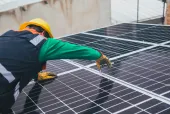Analysis of the electricity meters market in India
By Frost & SullivanSeveral sectors in India, especially industrial and infrastructural that include commercial and residential corridors, are presently witnessing substantial rise in investments. Extensive power capacity augmentation and improvement of electrical grid networks are imperative to support this growth. The need to have an efficient and reliable power distribution setup at both macro and micro levels is providing growth opportunities for the electricity meters market in India. Apart from billing purposes, electricity meters are also essential to monitor and manage energy consumption on the demand side.
Market Overview
As per Frost & Sullivan’s analysis, in financial year (FY) 2010-11 (April 2010-March 2011) the overall electricity meters market was estimated at $460 million, as depicted in Figure 1. Tariff meters and panel meters contributed nearly 90 percent and 10 percent, respectively. Transmission and distribution (T&D) utilities dominate the demand for tariff meters, whereas industrial end users mainly demand panel meters. With huge requirement from T&D utilities, primarily for installation at residential premises, single-phase electronic meters dominate the tariff meters segment with almost 65 percent demand in revenue terms. Also, huge investments planned by T&D utilities as part of the Restructured Accelerated Power Development Reforms Program (R-APDRP) are likely to provide an impetus to the demand for tri-vector meters.
Figure 1

In the panel meters segment, kWh meters generated 50 percent of the demand in terms of revenue in FY2010-11. But lately, multi-function meters have had increased uptake compared to kWh meters, due to their additional functionalities. However, higher price is a hindrance in their mass adoption. Dual-source meters find application in establishments that use diesel generators because of unreliable power supply from T&D utilities. The market for dual-source meters is expected to flourish owing to increased usage of back-up power.
Chart 1 depicts the market concentration of the top four participants in the tariff meters and panel meters segment in FY2010-11.

Presently, HPL Electric & Power Pvt. Ltd. (HPL), Secure Meters Pvt. Ltd., Genus Power Infrastructure Pvt. Ltd., L&T Ltd., and Landis+Gyr Ltd. dominate the Indian electricity meters market. Frost & Sullivan estimates that long-standing market presence, coupled with a wide product portfolio, focus on tariff meters market, and extensive market penetration are the key success factors for these participants. Schneider Electric India Pvt. Ltd. leads the panel meters market with over 40 percent share. Some smaller participants are now providing stiff competition to organized participants by gradually expanding their geographical coverage with low-cost products.
Distributors and panel builders/system integrators are significant intermediaries in the panel meters market, with over 90 percent of meters being routed through this channel. T&D utilities primarily procure tariff meters directly from manufacturers and in turn issue it to EPC contractors for installation. EPC contractors and panel builders/system integrators are also a significant intermediary for tariff meters primarily in electrification projects for the industrial and infrastructural segments.
Going Forward
The electricity meters market in India is expected to grow at a compound annual growth rate (CAGR) of 1012 percent between FY2010-11 and FY2017-18, as shown below in chart 2. The growing economy, coupled with industrial development, is set to drive the demand for higher energy consumption. With the industry moving toward high-end products, a technology-focused approach is the way forward for participants in the long run.
Burgeoning energy costs have led to end users focusing on energy conservation and management. Unlike developed nations, anti-tamper features are integral to tariff meter specifications in Indian T&D utilities apart from accuracy. The developing metering infrastructure in India offers manufacturers with opportunities to use innovative technology to provide immediate benefits to end users.
While Automatic Meter Reading (AMR) schemes are being put in place now, adoption of Automatic Metering Infrastructure (AMI) will be a continuous process. With increasing focus on power quality management, addition of transients and harmonics measurement features to panel meters is expected to be a key growth opportunity in the panel meters market.
Frost & Sullivan estimates that T&D utilities and other players with a wide product portfolio, focus on competitive pricing, and well-entrenched distribution network are likely to be successful in the Indian electricity meters market in next few years.
Chart 2

Authored by: Energy & Power Systems Practice, Frost & Sullivan - South Asia, Middle East and North Africa














 Advertise
Advertise











